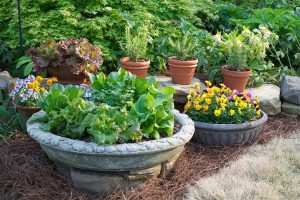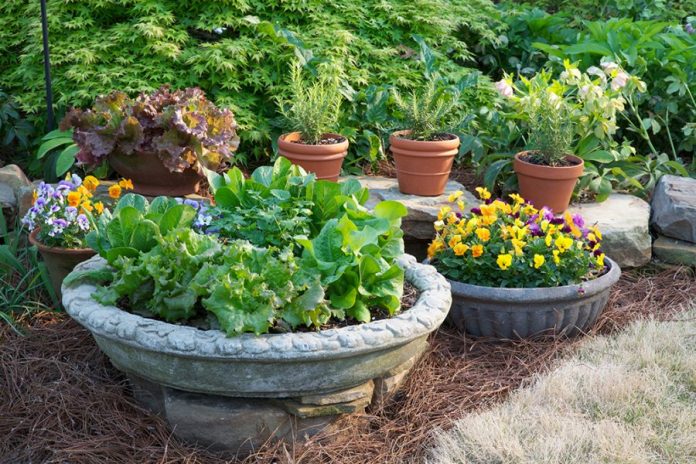
Europeans have been planting tidy little potager, or “kitchen gardens,” since at least Roman times.
The ancient idea, kept alive in picturesque medieval monasteries, is to step out the back door and gather a fresh salad. Today’s backyard vegetable gardens continue the tradition.
A terrific urban twist on the idea is to plant edibles in pots artfully arranged on the sunny edge of the patio.
Begin with big pots. “Big” means at least five-gallons. If the pots are crusty from previous use, put on your rubber gloves and scrub them in hot soapy water, rinse, then dip in a mild bleach and water solution to kill lingering microbes. If there isn’t a utility sink, a large plastic tub or small kid’s hard-plastic pool, a bathtub can be used for this activity. Place a large, heavy towel in the bottom to protect the finish from scratches.
Fill the containers with new commercial “potting soil” mix, that sterile black stuff in big bags at garden centers. Unlike backyard earth, commercial potting-mediums consist of peat and small chunks of white perlite, a volcanic residue that refuses to cave in over time. Plant roots like to wiggle around.
Read the bag labels. Many potting mixes sold retail contain 90-days-worth of slow-release fertilizer. According to Tom Leroy, retired Texas Agri-Life Extension Agent and professional plant breeder, with annual refreshing these mixes are good for three- to four-years of use.
Refreshing? All “soil” whether produced by Mother Nature or Corporate America is decomposing matter that breaks down into chemical units slurp-in by plant roots; and, tiny flora and fauna that set up housekeeping underground and in pots. At the end of the growing season that once-full container of “dirt” will be several inches lower than it was originally; and, its fertilizer will likely be depleted. Refilling the pot is refreshing it.
Feed stores sell professional growing mixes pressed into big tight cubes. These contain no fertilizers– nada, zip, zero. If you intend to sow seeds in the patio pot, line the bottom of the container with a combination of mix and slow release fertilizer, like chicken litter. If you start with bigger plants, mix a moderate amount of fertilizer into your growing medium. (The operative word here is moderate!)
Wet down the potting mix, leaving a one- to three-inch-deep reservoir at the top of the pot, where water can pool before being absorbed. Make sure the pot drains well.
Install the plant, then add mulch, which will hold moisture and moderate the temperature around the roots. As the season progresses, keep tabs on the moisture one-inch below the surface by inserting a clean pencil; water if no mix clings to the pencil. Leach the soil by drenching the pot once a month.
What if pesky fire ants take up residence in a pot? It is illegal to use Amdro in vegetable gardens. Two safe products Tom Leroy recommends are “Over and Out” and “Once and Done.”
Salad greens are cold-hardy during the winter months, but they are not immortal; so remember to bring them inside during extreme cold.








 GIF.gif)









